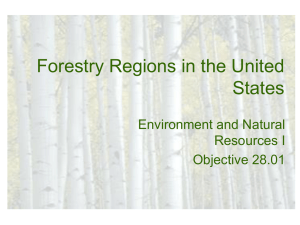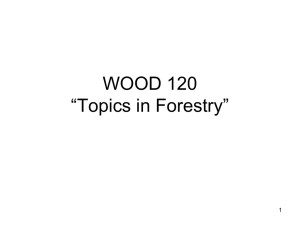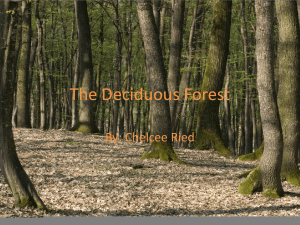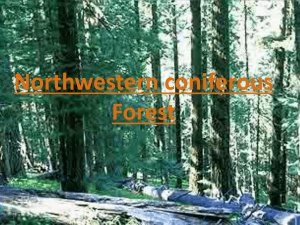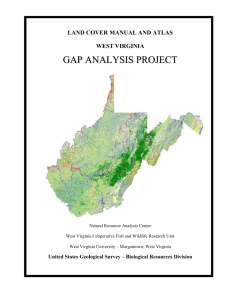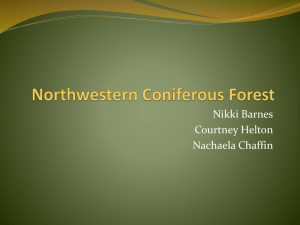Forests - WordPress.com
advertisement
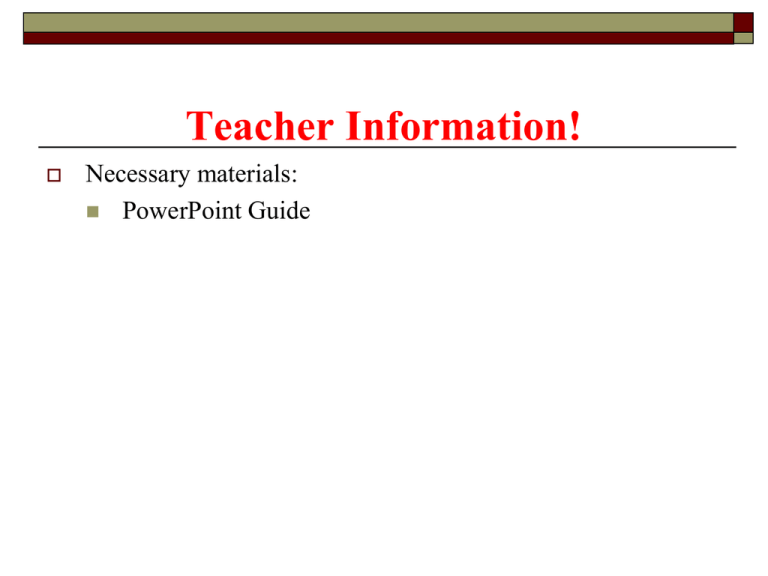
Teacher Information! Necessary materials: PowerPoint Guide Our Forests and Their Products Pgs 235-242 in Ch.19 of Managing Our Natural Resources Rangelands, Forests, & Fire Students will be able to… Define forest Describe the six forest regions in the U.S. The 1st Forestry Industry in the U.S. Began with the 1st European to set foot in North America Leif Ericson Leif and his Vikings established logging camps in northeastern Canada Harvested wood shipped back to Europe 600 years prior to the settlers of Jamestown Forests Occur where moisture is sufficient for tree growth Arid regions like the Great Plains too dry to support forests Complex community of trees and other organisms forest House = tree, city = forest A housing development ≠ city Clump of trees ≠ forest Forest: Friend and Enemy Dense forests made farming & settlement difficult But trees supplied materials for houses, forts, and ships Source of wild game and fruit Forests Today 749 million acres in the U.S. forested = 1/3 of the U.S. 2/3 of this = commercial forest 250 million acres of commercial forest are actually usable 1/3 (250 million acres) = noncommercial forest Commercial Forest that has economic potential Who owns commercial forestland? Private landowners 58% Government 28% Forest product industries 27% Weyerhauser, Kraft, Union-Camp Maine & New Hampshire > 80% forested Nebraska & North Dakota < 2% forested What trees are used in forestry? Two general kinds Softwoods Hardwoods Gymnosperms = conifers Douglas fir, blue spruce, yew Angiosperms = flowering, broad-leafed trees Oak, maple, beech, apple, cherry Most timber production softwoods U.S. Forest Regions Different species of trees have different requirements Different environmental conditions forest regions Climate Altitude Soil type 6 forest regions in continental U.S. U.S. Forest Regions West Coast Western Central Tropical Northern Southern U.S. Forestry Regions Hawaii and Alaska have their own four regions Coast Interior West Dry West Coast Pacific Ocean Central California Canadian border Most productive forest region About 48 million acres Produces > 25% of annual U.S. lumber production West Coast Tree Species Douglas Fir Coast Redwood Western Red Cedar Sitka Spruce Sugar Pine Lodgepole Pine Incense Cedar Port Oxford Cedar White Fir Red Alder Bigleaf Maple Western Mountainous regions From Canada to Mexico in the western states (west of the Dakotas and eastern Texas) Produces ~ 27% of U.S. lumber Western Region Tree Species Ponderosa Pine Idaho White Pine Sugar Pine Douglas Fir Engelmann Spruce Western Larch White Fir Incense Cedar Lodgepole Pine Western Red Cedar Aspen Central New York State to northern Georgia West to Texas North to Minnesota Much of this region has been cleared for crops Very diverse region Central Region Tree Species Shortleaf Pine Virginia Pine Red Oak White Oak Hickory Elm White Ash Black Walnut Sycamore Cottonwood Yellow Poplar Black Gum Red Maple Sweet Gum Tropical Southern tips Florida Texas Smallest forest region in U.S. Tropical Region Tree Species Mahogany Bay Tree Mangrove Northern From Maine south along the mountains to Georgia Northern Michigan Northern Minnesota Largest forest region in North America (extends across Canada and Alaska) although small in U.S. Northern Region Tree Species Eastern White Pine Red Spruce Black Spruce White Spruce Norway Pine Jack Pine Balsam Fir White Cedar White Ash Basswood Tamarack Eastern Hemlock Aspen Beech Red Oak White Oak Yellow Birch Black Birch Sugar Maple Southern Coast of Virginia to eastern Texas North to Missouri Very productive forest due to highly fertile soil Southern Region Tree Species Loblolly Pine Longleaf Pine Shortleaf Pine Slash Pine Bald Cypress Sweet Gum Black Gum Hickory Southern Red Oak White Oak Pin Oak Live Oak Willow Yellow Poplar Cottonwood White Ash Review Define forest Describe the six forest regions in the U.S.

